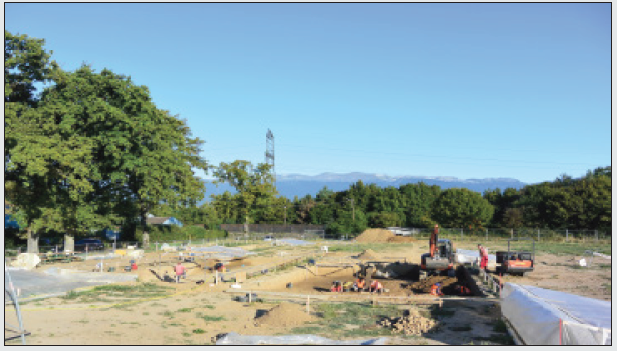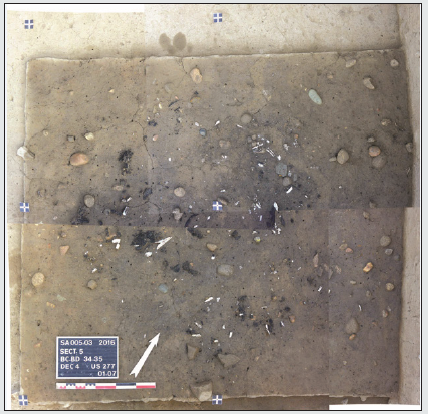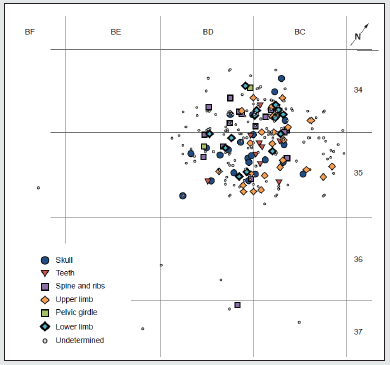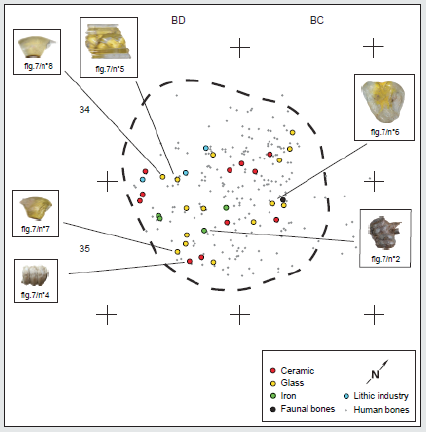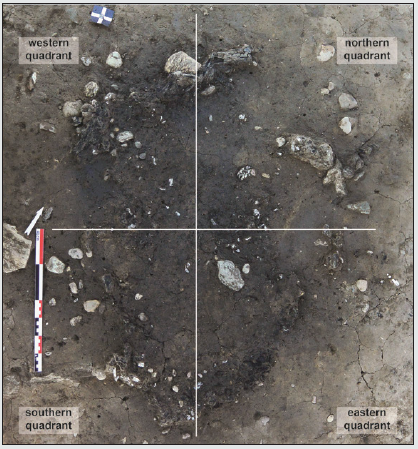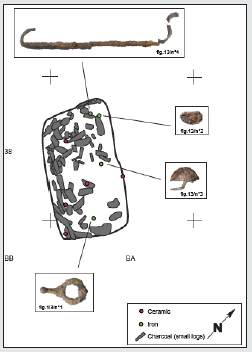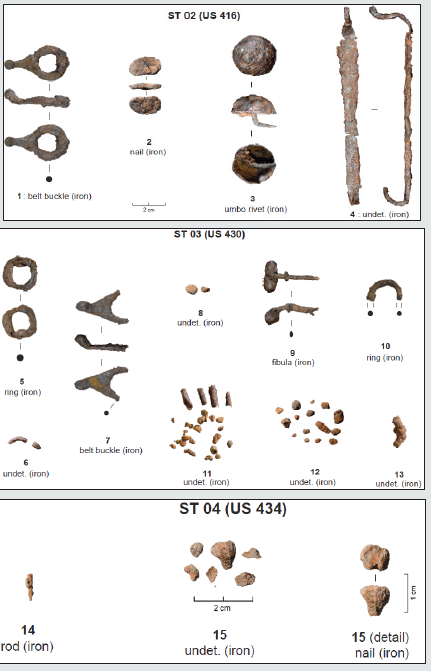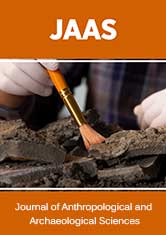
Lupine Publishers Group
Lupine Publishers
Menu
ISSN: 2690-5752
Review Article(ISSN: 2690-5752) 
Funerals During the Second Iron age: A Newly Discovered Sepulchral Ensemble Reveals Practices in Western Switzerland (Pré-Du-Stand, Geneva) Volume 4 - Issue 5
Marie Besse1*, Martine Piguet1, Antony Carbone2, Auréade Henry3, Stéphanie Girardclos4, Julie Debard1, Tobias Hofstetter1, Anouk Bystritzsky-Papilloud1 and Tara Steimer1
- 1Laboratory of Prehistoric Archaeology and Anthropology, Department FA Forel for Environmental and Aquatic Sciences, University of Geneva, Switzerland
- 2University Lumière Lyon, France
- 3CEPAM laboratory (UMR 7264), CNRS Université Côte d’Azur, Nice, France
- 4Department of Earth Sciences, Institut des Sciences de l’Environnement (ISE), University of Geneva, Switzerland
Received:July 20, 2021 Published: August 06, 2021
Corresponding author:Marie Besse, Laboratory of Prehistoric Archaeology and Anthropology, Department FA Forel for Environmental and Aquatic Sciences, University of Geneva, Uni Carl-Vogt, 1205 Geneva, Switzerland
DOI: 10.32474/JAAS.2021.04.000198
Abstract
During preventive archaeological excavations at the site of Pré-du-Stand in Geneva (Switzerland) in 2015 and 2016, four cremations dating to the middle La Tène period (La Tène C2/200-150 BC) were found. This discovery sheds light on Second Iron Age societies, which remain poorly understood to this day. Analysis based on existing anthropological knowledge and funerary artefacts suggest these structures represent a female grave, two warrior graves, and a deposit of charcoal and burned human bones. On the Swiss Plateau, the beginning of the Second Iron Age (LTA2-LTC2/425-150 BC) is characterised by inhumation necropolises. Cremation, meanwhile, disappears until 150 BC, when it makes a comeback. The recent discoveries made at Pré-du-Stand push back the appearance of cremations to the La Tène C2 period around 200 BC, and bear witness to the presence of two male tombs, a rare occurrence in the funerary context for this period.
Introduction
In Switzerland, the Iron Age marks the final stage of prehistory. Whilst the first Iron Age (the Hallstatt period) develops in continuity with the Bronze Age, the second Iron Age (La Tène) sees the emergence of several new and important features. Proper towns are built, money is generalised as a currency for trade, the processes of metallurgy are mastered, and commercial links with the Mediterranean South are developed. The Celtic populations inhabit villages along major communication routes, or fortified refuges on higher ground. The most important towns, or oppida, appear at the end of the 2nd century BC north of the Alps [1-3]. Concerning the funerary world, we notice a succession of various traditions, reflecting social organisation, ideologies and other invisible processes. Cremation underneath a tumulus is the norm during the first Iron Age, with the dimensions of the tumulus and the number of graves varying according to the main deceased’s importance [4]. During the 6th and 5th centuries BC, the hierarchisation of society is best illustrated by the princely Hallstatt sites and extremely rich inhumations. In Switzerland, no sites have yet been identified showing this phenomenon completely, but several have features hinting at these practices. These include, for example, the hydria found at Grächwil [5], the previously pillaged tumulus at Payerne (Vaud), and partially excavated site at Châtillon sur-Glâne [6-8]. After these sites disappear during the 5th century BC, inhumation in big necropolises becomes the rule until the 2nd century BC., when tumuli are abandoned. At the end of the Iron Age, we observe a change all over the Swiss Plateau, with big necropolises abandoned in favor of new funerary spaces and the re-appearance of cremations [9,10]. Given the absence on the Swiss Plateau of cremation deposits dated before 150 BC, particularly precious light could be shed on the Second Iron Age in Switzerland by the recent discovery of four such deposits recently discovered at the Pré-du-Stand site in Geneva, Switzerland, dated to around 200 BC.
This equilibrium phenomenon between inhumation and cremation is visible in several regions and has been studied in particular in Southern France [11]. Within this territory, cremation progresses as a practice from the end of the final Bronze Age, from West to East. From the second half of the 5th century BC, it become generalised in southern France. It is interesting to note that two regions resist this trend, namely the Greek colonies of Marseille and Agde and the meridional Alps. While the first region corresponds to allochthone Greek traditions, the alpine zone keeps the inhumation practice proper to the neighbouring Italian Piedmont area. This phenomenon of inhumation perduring is also perceptible in Valais [12]. Data from the Rhône-Alpes region have not been recently subjected to a synthesis but show that inhumation is the norm during the majority of the Iron Age [13-16]. To the North of Isère, small cremations pits dating to the final La Tène are mentioned at Mépieu [17]. This diffusion of cremation is not reflected in everyday life and material culture and remains limited to the world of the dead. Aiming to interpret changes in these funerary practices is difficult. The choice between inhumation and cremation does not necessarily imply a change in religious beliefs concerning what becomes of the deceased after death [18]. According to the few texts available for the end of the Iron Age as well as ethnological comparisons, populations seem to believe in a close or familiar after-death [18]. Burning or not the deceased is a way to allow him/her to join his/her ancestors in the beyond. While the reasons behind changes in funerary practices are difficult to apprehend, it is indispensable to be able to define them as precisely as possible, in order to compare them within a geographical area.
In this article, we present the geological and environmental context of the site and the archaeological context of the deposits therein, we discuss the contribution of our analyses in the methodological section, and present the site itself. We describe the four cremations, presenting in each case the anthropological and artefact analysis conducted. The anthracological analysis, meanwhile, is presented in a separate chapter. A detailed anthropological study helps to understand funerary architecture, the orientation and position of the deceased, their biological identity, the presence or not of a container. Funerary artefact analyses allow us to gain information on the funerary ritual, since the objects accompanying the deceased are the result of a choice obeying to certain rules. It might also help define the chronological insertion of the tomb, and to determine the gender of the individual. The anthracological analysis can serve as a comparison point for structures by determining the essences used ; it fully contributes to the comprehension of the funerary ritual. Finally, we demonstrate the important contribution of these new discoveries to our knowledge of funerary rituals during the Iron Age in Switzerland.
Geological and Environmental Context of Pré-Du- Stand
The archaeological site of Pré-du-Stand, used for agricultural purposes until 2014, has been preserved for millennia. In 2014, the site was identified through a series of test pits dug prior to the construction of a road. The study site is located in the municipality of Grand-Saconnex, covering a surface of roughly 60 by 75 meters, less than 2 km away from the “Petit-Lac” of Lake Geneva, the largest perialpine lake in Western Europe (Moscariello et al. 1998) (Figures 1A & 1B). The area of the Geneva basin corresponds to the western extremity of the relatively lowland Plateau situated between the Alps to the South-East and the Jura mountains to the North-West. The Swiss Plateau was heavily impacted by past glaciations when large ice masses carved deep valleys into Tertiary molasses bedrocks (Charollais et al. 2007). The Pré-du-Stand lies on a 4% slope (S-W to N-E) on the hillside of Grand-Saconnex, a 425 m a.s.l. promontory formed by a molasse covered to the bedrock by glacial and glacio-lacustrine sediments that were left by ice masses during the last deglaciation. These sediments deposited in a large proglacial and periglacial lake covering large parts of the Geneva basin [19]. During an undefined Late Glacial period, likely the Oldest Dryas (> 15.0–13.2 ka BCE) [20], these ancient glaciolacustrine sediments were exposed to terrestrial agents, and started to be altered. These reworked glacial deposits formed a succession of colluvial layers in many places of the Geneva basin including the Pré-du-Stand [21]. During the Iron Age, vegetation on the Swiss Plateau was characterised by fir-beech and oak forests that underwent quite intense deforestation in the Geneva area [22].
Figure 1a: Map of settlements and funerary sites of western Switzerland, as cited in the article: 1. Pré-du-Stand (Genève); 2. Genève-Cathédrale (Genève) ; 3. Genève-Rue du Vieux-Collège (Genève); 4. Chêne-Bougeries- Arpillières (Genève); 5. St-Sulpice-En Pétoleyres (Vaud); 6. Lausanne-Vidy (Vaud); 7. Vufflens-la-Ville (Vaud); 8. Pomy- Cuarny-La Maule (Vaud); 9. Châbles-Les Biolleyres (Fribourg); 10. Frasses-Les Champs Montants (Fribourg); 11. Avenches- Au Lavoëx (Vaud); 12. Courgevaux-Le Marais (Fribourg); 13. Bevaix-Les Chenevières (Neuchâtel); 14. Cortaillod-Petit Ruz (Neuchâtel); 15. Bern-Engehalbinsel (Berne); 16. Bern-Reichenbachstrasse (Berne); 17. Niederwichtrach-Bachtelen (Berne); 18. Basel-Gasfabrik (Bâle). (DAO: M. Piguet).
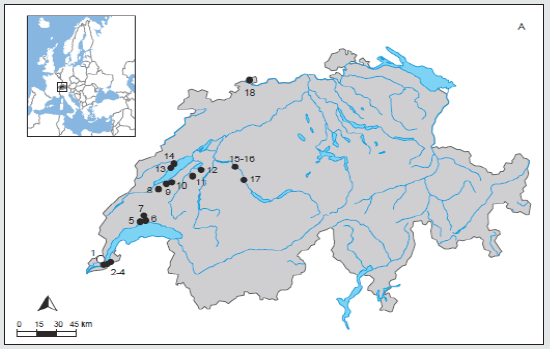
Archaeological Context : The End of the Iron Age in Western Switzerland
The cultural context of the Iron Age in Western Switzerland is marked by a collapse of the occidental Hallstatt domain over the course of the 5th century BC. In general, there are scarce traces of settlements during the early (La Tène A/450-400 BC; La Tène B1/400-320 BC; La Tène B2/320-250 BC) and middle La Tène (La Tène C1/250-200 BC; La Tène C2/200-150 BC). Towards the end of the middle La Tène (LTC2) and during the beginning of the final La Tène (LTD1/150-80 BC), the number of settlements increases again on the Swiss Plateau [23-29]. A similar tendency is observed in France and is interpreted as the sign of economic prosperity [30]. With regards to funerals, inhumation is the rule on the Swiss Plateau during the early and middle La Tène. There are a few exceptions such as the cremations at Chêne-Bougeries-Arpillières (Geneva) and at St-Sulpice-En Pétoleyres (Vaud), during the 5th century BC [30], but these are rare. After several centuries of absence, the practice of cremation reappears around 150 BC. In contrast, in the Canton of Valais, inhumation remains the norm during the entire La Tène period [31]. Known cremation ensembles from the Swiss Plateau are rare and sometimes isolated, with a predominance of female and children’s graves, and date mostly to the final La Tène period [32]. In the canton of Bern (Switzerland), two necropolises are contemporary to Pré-du-Stand: Bern-Reichenbachstrasse contains 36 inhumation graves and one potential cremation.
In the necropolis of Niederwichtrach-Bachtelen, 13 inhumation tombs were documented [33]. In northern Switzerland, the site of Basel-Gasfabrik covers the La Tène C2-La Tène D1 period and contains inhumation tombs [34]. In the current state of research [35], the appearance of cremations on the Swiss Plateau is dated around the beginning of the La Tène D1 in the canton of Fribourg, with two registered sites, namely Frasses-Les Champs Montants and Châbles-Les Biolleyres [36]. In the canton of Vaud (Switzerland), the necropolis of Lausanne-Vidy is biritual as early as the start of the La Tène D1, while at Avenches-Au Lavoëx at the same time, cremation is the rite used exclusively [37,38]. In the region of Bern, the cremation rite only appears at the end of the La Tène D1, demonstrating the persistence of inhumation in this region in contrast to the rest of the Swiss Plateau [38]. Regarding older studies, in 1931 and 1949 two urns were excavated at “Rue du Vieux-Collège” in Geneva and were dated to the final La Tène period [39]. Furthermore, the La Tène settlement at “Genève- Cathédrale” yielded two fibulas in the Mötschwil style dated to La Tène C2, bearing witness to exchanges with the Bern region [40]. Since they were found within a funerary context, these could indicate a grave, but as these layers were disturbed, doubt remains. The recent discoveries made at Pré-du-Stand (2015 and 2016, this study) and those at Vufflens-la-Ville (2015 and 2016, Vaud) push back the appearance of cremations to the La Tène C2 period. At the Vaud site, whose study is currently in progress, two funerary spaces were identified close to a settlement dated to the La Tène C2-La Tène D1. The first one comprises around 20 cremation structures with no particular layout, and funerary artefacts including fibulas and glass yellow-sheet bracelets. The second ensemble contains only inhumations [41].
Methodology
The diffuse character of cremation structures, especially when they are excavated from much-eroded terrain, imposes a multidisciplinary approach both on-site and in the laboratory. This study includes varied analytical methods: fine excavation, anthropological analysis of the human remains, typological study of the artefacts, radiography and restauration of specific pieces, use of an electron microscope, radiocarbon dating, and anthracological and sedimentological analyses. The cremation structure required very fine excavation, undertaken by anthropologists. The bones of the first structure were collected and registered in terms of their location in X, Y, and Z coordinates. The other structures, discovered later and subjected to time constraints for excavation, underwent a planimetric excavation. The bones were systematically collected and registered roughly every 1-2 cm, and the structures themselves were divided into quarters for excavation. Sediment was sieved through a 0.2 mm mesh. A database for general information was devised according to the protocol proposed by Duday (2013), registering for each bone its anatomical identity, its weight, the number of fragments, its colour, the type of fragmentation and which quarter of the structure it came from. Identification of several objects required further investigation before a typological study of the artefacts could be carried out. The iron artefacts were heavily corroded, making determination difficult (Figure 2A). X-ray diagnoses conducted at the History and Art Museum of Geneva by Colette Hamard and Bernadette Rey-Bellet enabled selection of the most valuable pieces to be restored (Figure 2B). Sanding of ten pieces was performed by Valérie Gapany at the History and Art Museum of Geneva to facilitate their identification (Figure 2C). A pearl found in the cremation structure 01 required an Energy Dispersive Spectrometry analysis interpreted by Branimir Šegvić of the Department of Geosciences of Lubbock University (Texas, USA), coupled with observation under an electron microscope realised by Agathe Martignier of the Department of Earth Sciences at the University of Geneva (Figures 2D & 2E). To confirm the date attributed through typology, two Accelerator Mass Spectrometry (AMS) radiocarbon dating were performed on charcoal samples from structures 01 and 02 by the AMS laboratory at ETH Zürich [42]. Samples from all four cremations underwent anthracological analysis. The aim was to determine the type of wood used for these structures and thus to obtain data on the practices linked to fire use in this specific context. Given that all the samples represent specimen from “closed features” i.e., charcoal associated to the funerary deposits, they are a prori unsuitable for paleoenvironmental reconstruction, as the wood may have been the object of a strong selection in the context of the funerary rituals. To get an accurate idea of the wood selection criteria, at least 100 charcoal samples were analysed from each structure, whenever the preservation state of the material allowed it. The heterogeneity of each feature was evaluated using taxonomic “effort-yield” curves [43], which are regression curves illustrating the evolution of the number of taxa identified according to the number of fragments analysed.
Figure 2: Methodology for determining an iron artefact (belt buckle, inv. 3447, fig. 13, n°1, Pré-du-Stand site (Geneva)): A: the object with corrosion. B: X-rays analysis (C. Hamard and B. Rey-Bellet , History and Art Museum of Geneva). C: After sanding (V. Gapany, History and Art Museum of Geneva). (A, C: photograph V. Gapany; B: photograph C. Hamard). D: magnification 40X. E. magnification 160X. E: Pearl, inv. 2432 (fig.7, n°4), Pré-du-Stand site (Geneva): photographs taken with a scanning electron microscope showing the raw material structure (photograph: A. Martignier, Department of Earth Sciences of the University of Geneva).
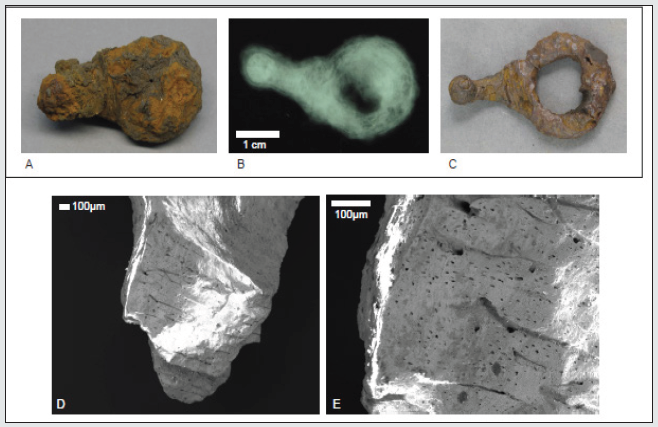
Wood charcoal was recovered by screening. The study focused on fragments over 2 mm in size. These were identified with a brightfield/darkfield reflection microscope, with magnifications of 100 to 500. The fragments were chosen randomly, albeit with a balance in the number of fragments belonging to each size class (over 1 cm; 4 mm-1 cm; and 2-4 mm) to avoid biases due to the taxonomical composition of the corpus. Indeed, observing only the largest fragments tends to unduly favour the most frequent taxa [44,45]. The charcoal samples were broken manually according to the three anatomical sections of the wood: transversal, longitudinal radial and longitudinal tangential. Identification was carried out by comparing the samples with the charred wood reference collection of the CEPAM laboratory (CNRS UMR 7264, Nice) and wood anatomy atlases [46,47]. The complex topography and chronology of the site was addressed by detailed sedimentological study, undertaken as soon as the excavation started. To this end, regular sampling and observation took place at various locations of the site.
The Four Structures of La Tène at Pré-Du-Stand
General overview and absolute dating
Rescue excavations were conducted in 2015 and 2016 in the canton of Geneva at the Pré-du-Stand site, led by two of the authors (Marie Besse and Tara Steimer). These brought to light a series of archaeological layers, each very different and separated from the other by colluvium levels. These layers consist of middle Neolithic remains (a hearth, plough marks, manure), traces of the final Neolithic (two menhirs, some postholes, plough marks), Bell Beakers, early Bronze Age (wattle, pit, hearth), final Bronze Age- Hallstatt (hearth, pit, plough marks), of the middle la Tène (cremation deposits), of the final la Tène (drains) and finally of the Roman period (stoneway) [48]. Four cremation deposits dated to the middle La Tène period (La Tène C2/200-150 BC) were uncovered (St. 01, St. 02, St. 03, St. 04) (Figure 3). Discovered within an area measuring around 10 m2, these secondary deposits are partially organised. Indeed, three are aligned along a northsouth axis, around three meters apart. Two of the structures show a planned layout strategy, while the remaining two are more diffuse and raise questions regarding the funerary practices of these populations (Figures 4-6).
Figure 5: ST 01 (US277), Pré-du-Stand site (Geneva): A. Distribution of percentages of weight by anatomical attribution, including undetermined. B. Distribution of percentages of weight by anatomical attribution, excluding undetermined. (DAO: J. Debard).
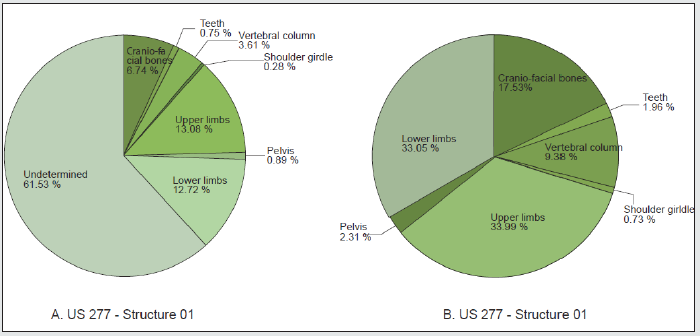
The four cremations of Pré-du-Stand share several common features. These are : their stratigraphic location, their geographical proximity, the alignment formed by three of them, the type of deposit, the colour and fracturing of the bones, the radiocarbon dates, and the artefacts. Based on this evidence, we consider the four cremations to be contemporary and dated to the La Tène C2 period. Indeed, the two radiocarbon dates (ETH-69449 and ETH- 70463) obtained on charcoals from structures 01 and 02 yield, at two-sigma confidence, an interval matching a middle La Tène attribution. The chronological interval is 383 to 200 cal. BC at 2 sigma [49-51]. This is slightly older than the typological attribution given by other elements of the cremation, which belong to the La Tène C2 (200-150 BC). These include a glass yellow-sheet bracelet (Figure 7, n°5), a glass pearl of the same material (Figure 7, n°7-8), and two iron belt buckles (Figures 8-13, n°1 and n°7). This slight chronological discrepancy between the radiocarbon dates and the artefacts is reasonably explained by the “old wood effect”; in other terms, that the date obtained from the charcoal (oak wood) in structure 02, dates an episode in the formation of the oak tree itself and not the date at which it was burned. Thus, the charcoal probably originated at the heart of the tree. Three objects can be associated with the middle La Tène in general (LTC1 and LT C2) : two fibula elements (Figure 7, n°2 and Figure 13, n°9) and one rivet from a shield’s umbo (Figure 13, n°3). The four cremation deposits are stratigraphically equivalent as they are included in the same sediment and sealed by a silt-clay layer, brown-red in colour, two to five centimetres thick. No bone or charcoal deposit was observed anywhere else outside of the deposit boundaries, indicating a quick sedimentary fill, either anthropogenic or natural. A few calcinated bone fragments, however, were found scattered throughout the surface of the Hallstatt sediment within which lies St.01, but not next to other structures. This scattering is probably linked to the layout of St.01, which was disorganised and with blurred limits. Bone fragments could therefore have been dispersed and disturbed a posteriori.
Figure 7: Archaeological artefacts of St 01 (US277), Pré-du-Stand site (Geneva). Scale: 1/1: n°1-4, 9-15, 19. 2/3: n°5-8, 17, 18. (DAO: A. Carbone).
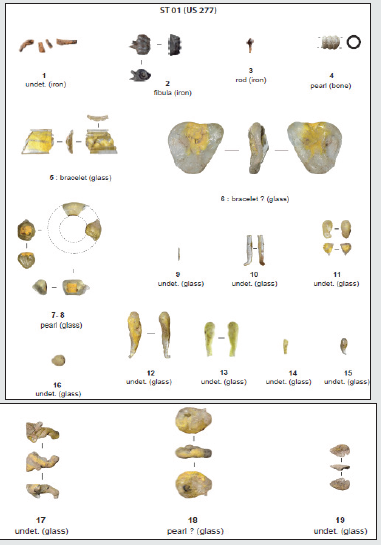
Figure 11: ST 02 (US416), Pré-du-Stand site (Geneva): A. Distribution of percentages of weight according to anatomical attribution and excavation quarters. B. Distribution of percentages of weight by anatomical attribution, including undetermined. C. Distribution of percentages of weight by anatomical attribution, excluding undetermined. (DAO: J. Debard).

Figure 12: ST 02 (US416), Pré-du-Stand site (Geneva): A. Distribution of percentages of weight according to anatomical attribution and altitude, including undetermined. B. Distribution of weight percentages according to altitude. (DAO: J. Debard).

Archaeological facts and comparisons
Structure 01
Structure 01 (US277) is oval in shape, with many charcoal fragments, 150 cm long and 130 cm wide, and 8 cm deep. The limits of this structure are blurred, and the largest charcoal fragments are very dispersed. There is no indication of any container being present; this therefore appears to be a deposit made directly on the ground, with no particular structural arrangements (Figure. 4).
Anthropological analysis
The human bone fragments weigh in at 369.53 g (of which a third are identifiable), with a majority of bones belonging to the upper limbs (48.33 g, or 13.08%), to the lower limbs (46.89 g or 12.72 %) and cranio-facial bones (26.91 g or 6.74 %). Among the teeth (2.78 g or 0.75%), a third left upper molar is identifiable, as well as a third right upper molar with a cavity going all the way down to the cement-enamel junction. There is also a third left upper premolar and a second right upper premolar. The vertebral column and pelvic girdle are only represented in small quantities (respectively 13.33 g, or 3.61 % and 3.28 g, or 0.89 %) (Figure 5). Hands and feet are completely absent. Anatomical elements attest to the presence of only one individual (MNI=1). The total weight of the bones, 369.53 g, is however too low for it to be a complete individual. While there is some debate as to the average weight of an individual after cremation, the current prevailing opinion puts it at around 1760.3 g and no lower than 1227 g [51]. The bones were too fragmented to determine age and sex by conventional methods [52,53]. Indeed, no morphological indications of robustness or gracility could be observed. On the other hand, the dental fragments including tooth roots are all clearly mature; therefore, the authors lean towards concluding that this was an adult individual. The fragments are white-cream in coloration, indicating exposure to a hot fire (700 to 1000 °C) over a relatively long period of time (Walker et al. 2008; Depierre 2014). The fracturing of the bones is characterised by hexagonal furrows on the articular surfaces, fine lines on the flat bones, and parabolic fractures on the long bones, indicating flesh was still present when the bones were burned [54,55]. The spatial distribution of the anatomical pieces clearly demonstrates that there was no particular organisation to the deposit. The bones seem to have been dispersed with no regard to anatomical attribution (Figure 6).
Grave goods
Apart from the bones, the structure yielded artefacts of glass, iron, ceramics and a few lithic pieces. The unique faunal fragment identified belongs to a goat’s ulna, white-cream in colour, with parabolic fracturing, all identical to that observed on the human bones, indicating a combustion of “fresh” bone at a high temperature.
a) Glass artefacts
Fifteen glass elements were found in this structure, both melted and intact. A bracelet fragment was found preserved from the flames (Figure 7, n°5). It is made of uncoloured glass, featuring an internal yellow sheet with a 5-side plano-convex structure, the size of the sides decreasing from the centre to the edges. The central side presents oblique impressions giving the illusion of a coil. It is attributed to style 8c of T.-E. Haevernick (1960) and to style 40 of R. Gebhard (1989a, b). It is typical of La Tène C2. Another melted fragment with a yellow inlay (Figure 7, n°6) probably belongs to the same bracelet. A few similar specimens were found in occidental Switzerland in the cantons of Vaud and Fribourg [56] but the area that yielded the most examples is the region around Bern (Kaenel 1990). Glass bracelets from this period are highly varied: segmented with longitudinal transversal or oblique sides and ornamented with zigzagging yellow and/or white strands. The Pré-du-Stand specimen is similar to two bracelets found out of context at Villars Ste-Croix (Vaud) and Marsens La Pierre (Fribourg), both belonging to the 8c style [57],pl.57 n°1, pl. 76 n°2). In its dimensions, however, it is closer to the former (Figure 14).
It is worth noting the presence, at Chancy Passeiry (Geneva) of two glass bracelets, cobalt blue in colour, one belonging to the 8d style with a central side segmented diagonally, the other belonging to style 7c (Kaenel 1990, pl.4 n°1 and 2). One glass bracelet was also found in the “Quartier des Tranchées” [58] and another, rather similar to the Pré-du-Stand one, was found at Corsier (Curdy, Kaenel 2008, fig.325). At Pré-du-Stand, two elements probably belong to another artefact, one partially melted fragment (Figure 7, n°7) the other unmelted (Figure 7, n°8), both identified as part of an annular pearl, made in triangular-section glass, 3.5 cm in diameter. The glass is uncoloured, with a yellow sheet on the internal surface. The pearl fits within the Ic series of R. Gebhard (1989a), in group 20 of T.- E. Haevernick (1960) and in style 1.2.1 of M.-A. Zepezauer (1993). The Pré-du-Stand pearl features a notable difference: although it is D-shaped, it has two marked panels.
These yellow-sheet pearls are mostly found in the “Rhenish Palatinate” region and in eastern Switzerland and are often identified within cremations [59]. This pearl is similar to that found in the Fribourg site of Bösingen-Blumisberg [60], pl.63 n°2 and resembles that of Ollon Villy-En Champ Blanc (Vaud) [30], (pl.21 n°12) despite the latter being of more reduced proportions. Based on the yellow sheet coloration, these elements are attributed to the La Tène C2 period. Several melted glass fragments bear yellow traces, which indicates that they were either part of the bracelet (Figure 7, n°5), the annular pearl (Figure 7, n°7-8), or of other unidentified elements (Figure. 7, n°10-19). Only one fragment (Figure 7, n°9) bears no yellow coloration. These uncoloured glass objects found at Pré-du-Stand are interesting since there are a rather uncommon find for western Switzerland.
b) Iron artefacts
A stem, around 8 mm long with a circular section, was topped off by a rounded head. This element, which does not resemble a nail, could correspond to a moulding such as that found on the foot base of LTC2 fibulas, even if the stem is rather frail (Figure 7, n°3). A 4-spiral fibula spring bearing the start of the external cord is present, a typical element of La Tène C (Feugère 1a2, Feugère 1985) (Figure 7, n°2), while several stem fragments with a 2 mm long circular section could belong to a fibula (Figure 7, n°1).
c) Artefacts of diverse materials
Seven fragments were identified as belonging to a tubular 9 mm long pearl made of bone (Figure. 7, n°4). The raw identification required an EDS (Energy Dispersive Spectrometry) analysis coupled with observation under an electron microscope (Figure. 2, D and E). Its shape is quite similar to Chalcolithic and early Bronze Age pearls [61], (Figure 15, p. 52 et 138, n°33, n°25, n°17), but the attribution of this pearl to a middle La Tène structure is unquestionable. No similar specimen has been found in the La Tène corpus we consulted [30-33]. Finally, among the 18 ceramic fragments found in this structure, only one is clearly burned. The others bear no traces of heating, and their ancient appearance could indicate that they were part of the surrounding sediment rather than of the structure itself. Three lithic flint and quartz fragments, as well as two cob fragments were also found, but their relationship with the structure is unclear.
d) Discussion
The distribution of the material shows no particular agency, which is not surprising for a secondary deposit (fig. 8). The glass artefacts systematically bear traces of heating, either discreet (Figure 7, n°7 and n°10), or very strong, melting some pieces entirely (Figure 7, n°6, n°11-13, n°17-19). Only two fragments were not subjected to heat (Figure 7, n°5 and n°8); one belongs to a bracelet, the other to a pearl. Two other fragments (Figure. 7, n°6 and n°7) belong to the same artefacts (bracelet and pearl) but were melted. These objects were probably part of the funeral outfit worn by the deceased before they were cremated on the funeral pyre. Some elements of these ornaments either broke before the cremation, or were preserved from the heat by falling from the pyre before being collected for the secondary deposit. Glass melts between 550 and 700 °C. Fresh bone, meanwhile, turns a chalklike colour and fractures parabolically from 700 °C onwards [62]. Ornaments, apart from clothing accessories such as fibulas, seem to be the preserve of female individuals during the second Iron Age, especially glass objects [21-25]. Structure 01 is therefore considered a female grave, even though anthropological data cannot confirm it; alternatively, it simply represents the waste deposit of a pyre. In fact, the low weight observed in this structure could be the result of a selection of “parts” going into the final deposit, or this could be the waste or residue from another cremation [14-18].
Structure 02
Structure 02 (US416) is a rectangular pit, 130 cm long in its upper fill, 70 cm wide and 23 cm deep. Its limits are clear (Figure. 9). Wooden charcoals, sometimes in the shape of small logs up to 15 cm long, were deposited at the bottom and on the sides of the pit. The fill of the pit, however, is more heterogeneous and includes earth, gravel, small charcoals, burned human bones, faunal elements, and archaeological artefacts (Figure 10). No traces of rubefaction were observed on the surrounding sediment.
Anthropological analysis
The human bones are generally well preserved (1 to 5 cm long) and have a total weight of 1321.78 g, of which over half were identified (Figure 11A). All anatomical regions are represented, with a prevalence of lower limbs (184.93 g or 13.99 %), craniofacial bones (156.97 g or 11.88 %), upper limbs (120.37 g or 9.11 %), and vertebral column (117.42 g or 8.88 %) (Figures 11B & 11C). Meticulous excavation did not yield any indication of particular agency within the structure, of any organised distribution, or of any logical anatomical disposition (Figure 11A). The distribution of weight by altitude shows higher percentages at median altitudes where the structure has the largest aperture (Figure 12A & 12B). The proposed vertical distribution clearly shows the prevalence of the cranio-facial bones in the upper layers of the structure, whilst the lower limbs are lower down (Figure 12A). The anthropological analysis yielded an MNI of one, the sex of whom could not be determined, despite some secondary characters (occipital crest, orbital rim) being robust. The observable metaphysis, articular surfaces, teeth, and dental roots all show an adult degree of maturation.
Two pathological lesions were observed: the right calcaneus presents a small degenerative lesion on its superior surface at the point of tendon insertion, and the first right metatarsal has some slight osteophytes on the proximal articulating surface. The colour of the bones is, on average, between grey and white, indicating exposure to a temperature of at least 600 °C [63]. The ribs display the most diverse colour palette (grey, white, black, blue, brown). The colour follows a gradient, tending towards blue as the rank of the rib increases. These differences can be attributed to the anatomical position of the individual during the cremation: if the individual was placed on their back, the abdomen would have burned more slowly. This is because of the large amount of organic matter present (lungs, viscera, etc.), which can slow down fire action on the anterior surface of the rib cage. This could in turn prevent some bone elements from burning completely, and therefore prevent the white-grey coloration that seems to be the norm on other anatomical elements [35]. Articular surfaces present hexagonal fractures, and flat bones show some fine and linear fractures, as are usual on this type of anatomical elements. Parabolic fractures are also present on long bones of the lower limbs as well as on some cranial fragments, allowing us to affirm that the cremation took place on “fresh” bone, shortly after death [4,5].
Grave goods
This deposit yielded four iron artefacts, six very small ceramic fragments, and two faunal bones presenting the same colour and fracturing as the human bones, indicating once more a cremation on fresh bone. The four iron objects were extremely corroded and appear within the intermediate fill of the structure. Amongst these objects, there is a belt buckle composed of a ring, a triangular latch, and a perpendicular base bearing a button, identified as being of type 4B of G. Bataille (2001) and of the form 2 of Th. Lejars (2013) (Figure. 13, n°1), typical of La Tène C2. Characterised by their right-angled button, these buckles are associated with a sword suspension system, as made evident through several discoveries associating sword and buckle. Such discoveries include Sion, Sousle- Scex (Valais), Conthey, Râpes d’Aven (Valais) [14] or Vevey, En Crédeyles (Vaud) [18]. Some mineralized bone is present on the superior aspect, the result of contact contamination. The size of the buckle is small (36 mm long), but such specimens are known to depend on the type of harnessing preferred.
A second iron object is a rivet with a hollow hemispherical head, 2.5 cm in diameter and with a short stem, square in shape (Figure 13, n°3). The stem has been artificially hardened, indicating that it has gone through wood. The thickness of the reconstructed plank would have been around 7.6 mm. Hardware materials are usually multifunctional, discouraging characterisation, but in this case this nail can reasonably be identified as a rivet, used to fix an umbo to its shield. The presence of a belt buckle in the same deposit reinforces this interpretation and allows for the hypothesis of a grave with weapons. In comparison with the hemispherical umbo rivets from La Tène (Neuchâtel) (Schwab collection); [40], the dimensions of the Pré-du-Stand specimen fit within larger models, the head diameter of which exceeds 20 mm. The height of the head (11 mm) is, however, more important: at the La Tène site (Neuchâtel), the highest specimens do not exceed 7 mm. The thickness of the wood, evaluated at 7.6 mm, is coherent with the values from the Schwab collection, comprised between 7 and 15 mm, but it is rather small in comparison to A. Rapin’s evaluation [10].
Rivets with large hemispherical heads are rather characteristic of umbones with high rectangular fins [10]. This style endures for a long time : there is an ancient form (type 1a) dated to LTB2, a classical form (type 1b) dated to LTC and an evolved form (type 1c) restricted to LTC1/C2 and to LTC2. Three fragments form a long, flat stem with a quadrangular section, curved at one extremity and 13 cm long for 0.9 cm in width (Figure 13, n°4). This could be a cleat to assemble wooden elements, but its form is not very characteristic. With the presence of an umbo’s rivet and a buckle in the same deposit, the hypothesis of this element being a shield’s handle cannot be excluded. The object could have undergone deformation during its recovery from the primary deposit. Finally, two fragments are attributed to a circular nail head, used in woodworking (Figure 13, n°2).
Discussion
This funerary structure has therefore yielded two markers of the warrior world, the suspension buckle of a sword and an umbo’s rivet, which is coherent with the anthropological study which indicated a robust individual, potentially a male. These artefacts indicate a rather high-standing deceased, who was deposited on the funeral pyre with at least part of his warrior attributes.
Structure 03
Structure 03 (US430) is sub-circular, 80 cm in diameter and 12 cm deep. It contains numerous clusters of burned bone fragments, as well as a few dispersed charcoals (Figure 14). A wall effect is easily observable around the deposit, bearing witness to a probable container made of perishable material or of a hollow dug in the sediment. There is no bone outside the structure, and the unstable position of some fragments, as well as the low presence of sediments inside the structure itself, indicate that it was sealed shortly after its deposit, either with a cover made of perishable material or by rapid sedimentation.
Figure 14: ST 03 (US430), Pré-du-Stand site (Geneva): A. Distribution of percentages of weight according to anatomical attribution and excavation quarters. B. Distribution of percentages of weight by anatomical attribution, including undetermined. C. Distribution of percentages of weight by anatomical attribution, excluding undetermined. (DAO: J. Debard).
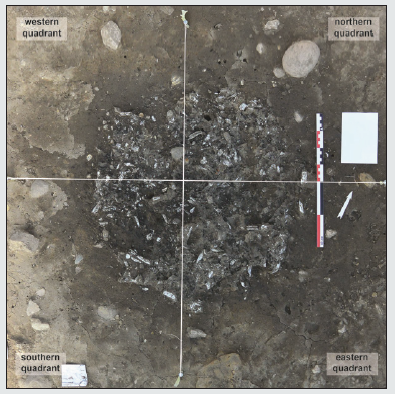
Anthropological analysis
All anatomical regions are represented within this structure, for a total weight of 1633.54 g. Excluding unidentified fragments (1088.16 g), the heavier elements belong to the cranio-facial bones (160.6 g or 9.83 %), the upper limbs (127.25 g or 7.79 %), the vertebral column (97.03 g or 5.94 %) and the lower limbs (95.31 g or 5.83 %) (Figures 15A , 15B & 15C). The distribution of the bones, by structure quarters and by altitude, revealed no particular agency and no anatomical logic, with the exception of a very small prevalence of the cranio-facial bones in the eastern quarter (Figure 15A). The identification of two left temporals and two chin prominences indicates that at least two individuals are present within the deposit. The total weight of the bones, however, is too low to represent complete individuals [24]. The bone fragments are in majority white grey to white-cream in colour. The fractures resulting from heat are identical to those found in the previously described structures of Pré-du-Stand.
Figure 15: Photography of the top of St.04. The deposit is cut by a modern drain. (Photograph: T. Steimer).
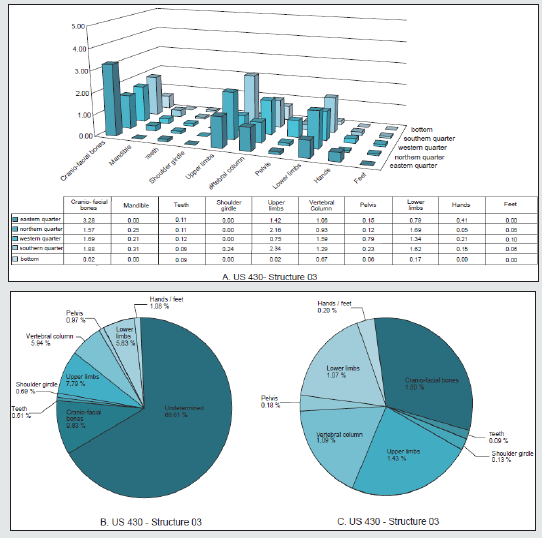
Grave goods
In this structure, several heavily corroded iron artefacts were found, including a belt buckle, a ring, a spring, and the arch of a fibula. Four small ceramic fragments complete this ensemble; it is however possible that these belong to the surrounding sediment. Several faunal bones are also present, with the same kind of coloration and parabolic fracturing, indicating that they also underwent heating while fresh. Among the identifiable elements, there is one swine tooth, a mandibular fragment from a ruminant, and the radius of a small goat. The belt buckle (Figure 13, n°7) is incomplete and of the same type as that discovered in structure 02, with a circular clasp and a triangular latch (type Bataille 4B, form Lejars 2). It also belongs to the suspension system of a Celtic sword and is dated to the La Tène C2. It could have functioned with the ring, which has a diameter of 2 cm (Figure 13, n°5). There is a ring fragment, also 2 cm in diameter, which could have either belonged to the buckle (Figure 13, n°7) or been a second ring standing on its own (Figure 13, n°10). Indeed, it is not excluded that these rings might have belonged to the sword’s suspension system, either as connecting elements between the various belt straps, or between the straps and the trigger guard of the sheath. Another recognisable artefact is the spring from a fibula, with six spirals and an external cord, as well as a fragment from a filiform arch around which an extension ring was attached (Figure 13, n°9). These two characteristics are typical of a middle La Tène fibula belonging to the Feugère 1a1 type [26], similar to the specimen found in structure 01. Moreover, several stem fragments could belong to fibulas or unidentified objects (Figure 13, n°6, n°8, n°11-13).
Discussion
Just like structure 02, the presence of a buckle and a suspension ring argue in favour of a grave with weaponry, for at least one of the individuals it contained.
Structure 04
Aligned along the same axis as structures 02 and 03, structure 04 (US434) is a relatively dispersed bone deposit, within a shallow pit 70 cm long and 40 cm wide, for a depth of 4 cm. The structure had no clear limits, having been cut by a modern drain that disrupted the western side of the deposit. The burned bones were extremely fragmented and dispersed, mixed with a few small charcoal fragments (Figure 16).
Figure 16: ST 04 (US434), Pré-du-Stand site (Geneva): A. Distribution of percentages of weight according to anatomical attribution and situation within the m2. B. Distribution of percentages of weight by anatomical attribution, including undetermined. C. Distribution of percentages of weight by anatomical attribution, excluding undetermined. (DAO: J. Debard).
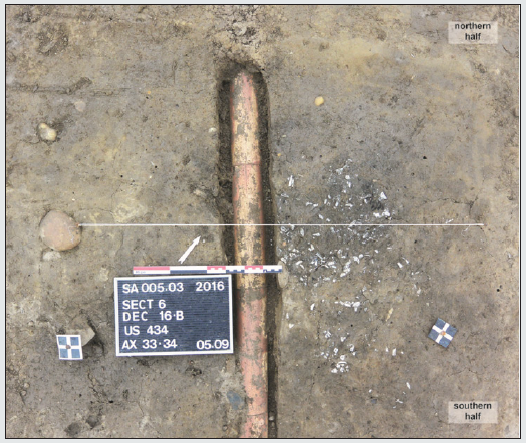
Anthropological analysis
The considerable fragmentation of the bones meant only 18 % could be determined. A total of 229.16 g of bones was recovered, 188.91 g of which being undetermined. Of the remaining weight, there is a prevalence of the lower limbs (16.21 g or 7.07 %) and of the cranio-facial bones (10.02 g or 4.37 %). The shoulder and pelvic girdle are not represented, and the upper limbs only appear in very small quantity (3,19 g or 1,39 %), and consist exclusively of humerus fragments (Figures 17A, 17B &17C). The spatial distribution of the bones shows no anatomical logic and no planned layout (Figure. 17, A). The MNI is one. The irregular distribution of the remains, despite the loss of a third of the structure to the modern drain, indicates that this could not possibly have been a whole individual [24]. Bone coloration oscillates between greywhite and white-cream, indicating exposure to strong heat over a long period of time. Unsurprisingly, hexagonal fractures on articular surfaces and parabolic fractures on long bones once more indicate a cremation of a fresh cadaver.
Grave goods
There are few artefacts in this structure: only a few small ceramic fragments, two of which are burned. There is also a quartz fragment and two small iron objects, an iron stem and a small nail (Figure 13, n°14 and n°15).
Two faunal fragments-one undetermined vertebra and a fragment of goat rib-complete this ensemble. The faunal pieces have the same coloration and fracture pattern as the human ones, indicating they underwent the same treatment.
Discussion
The poor preservation state of the structure, the anthropological remains, and the grave goods, do not allow us to determine the sex of the deceased of the function of the deposit.
Anthracological analysis
Many of the charcoal fragments are characterised by the presence of an orange deposit covering and infiltrating the cellular structure. The proportion of such altered fragments is high, with a total of 51% of altered fragments : 44% for structure 01, 70% for structure 03 and 90% for structure 04, the contents of which generally displayed the worst state of preservation. This last percentage led to interrupting the charcoal study at 50 fragments for this structure. The surface alterations of these charcoals, which are probably post-depositional, tends to favour deciduous oak over other taxa, as this taxon is identifiable based on few criteria. Namely, these are its large early wood vessels and very wide rays, which can be recognized from very limited analysis surfaces of only a few hundred microns and from a single transverse section. Hence, identification problems led to an additional taxonomical group, namely “undetermined, non-Quercus angiosperms”. Other phenomena affecting the microanatomy of the wood, such as lignivorous fungi, cellular collapse, or vitrification, were observed only punctually and had no impact on the identification.
Figure 17: ST 04 (US434), Pré-du-Stand site (Geneva): A. Distribution of percentages of weight according to anatomical attribution and situation within the m2. B. Distribution of percentages of weight by anatomical attribution, including undetermined. C. Distribution of percentages of weight by anatomical attribution, excluding undetermined. (DAO: J. Debard).
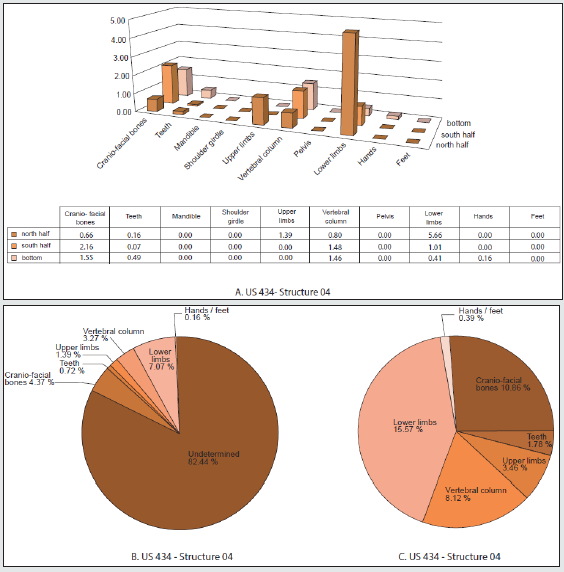
Discussion
Charcoal results for the samples drawn from the cremations yielded comparable profiles. Contrary to the initial hypothesis, the norm was not to drastically select one species over another, but rather a selection based around one main species, without this choice being an exclusive one. Indeed, the minimum number of taxa (MNT) ranges between one and eight (Figure 18 and Table 1). Structure 02, during excavation, was notable by the presence of large charcoal “logs” on the bottom and sides of the pit, giving the impression that they were deliberately placed there to form a “container”. The fill, meanwhile, was a mix of sediment, burned bones and charcoal fragments. It is worth noting that in this case, oak was the only taxon present, while in the other structures (where the flora observed is more diverse, MNT=5), no such “container” was observed. In the end, the disposition of these logs raises several questions. Is it possible that these burned logs constitute an architectural element, a container or a receptacle ? While this hypothesis may be the simplest in terms of function, it is hardly defendable when considering the logs are thoroughly burned, an act that can only have taken place before filling and sealing, thus invalidating their function as a receptacle.
Figure 18: Taxonomic curves (effort-reward) of the samples studied for the four cremation structures. (DAO: A. Henry).
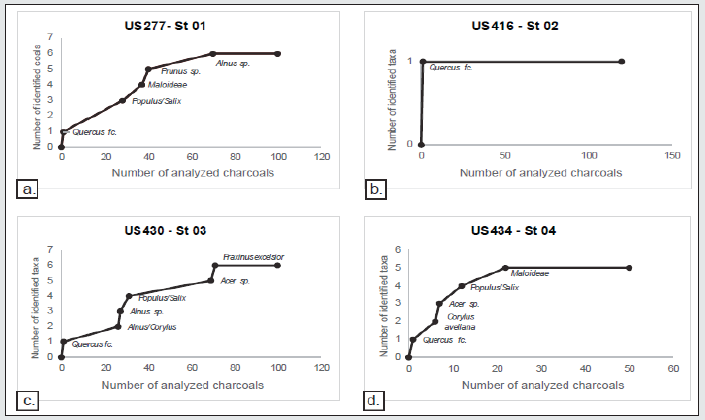
Table 1: Anthracological results of the four cremations. (FA = absolute frequency; undetermined have been excluded from percentages).
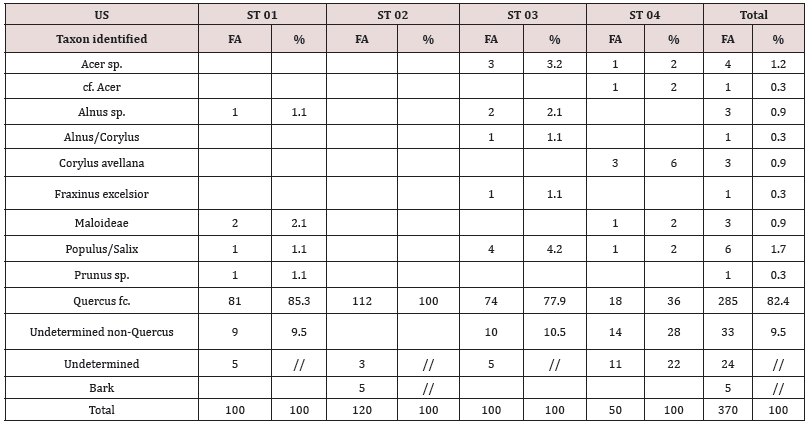
It is, however, possible that the aim was simply to delimit the edges of the pit, with a motivé that thus far remains unclear. This kind of practice is attested to in other chronological contexts, including during the high Middle Ages, where it is considered a “throwback” to ancient pagan traditions (Roux, Grand 2005). In the Lorraine region (France), some Iron Age graves built under a tumulus often rest on a “bed of ashes” (Leroy 1986, p. 297). The hypothesis of a bed of charcoal can be defended, despite the “carbonised log-like” aspect observed during excavation. It is important to mention that what might look like a unique small “log” of charcoal in the course of the excavation has sometimes been found, under microscopic observation, to be an amalgam of several pieces of charred wood distinct from one another. This was observed on several occasions during the anthracological analysis of several samples taken from such charcoal “logs” several tens of cm long at the site of Bondoufle (Henry, unpublished results). In the case of structure 02, it is not possible to investigate this possibility, since the collected “logs” are now fragmented.
The taxa associated with oak in other funerary deposits are mostly riparian species, such as Populus/Salix and Alnus. The remaining taxa, associated with forest edges and/or waterways, could have been collected near the site. The only deposit that differs from this selection of oak plus a few secondary taxa is structure 04. Indeed, in this case oak is in the minority, and other angiosperms predominate. Such taxa are also found in structures 01 and 03, albeit in considerably different proportions. This being said, the poor preservation of the material from this structure does not allow for greater discussion of these differences and their meaning. Overall, there does not seem to be a norm concerning the wood selected for cremations and the taxonomic composition does not seem related to the gender or social status of the individual; one or more taxa are present, reflecting a motivation which cannot be determined and which led different authors to hypothesize two possibilities: either the use of small logs (bundle) for the deposits composed of shrubby species or coppices (oak, ash) or, on the contrary, the use of whole trees for monospecific deposits [25].
Finally, only structure 02 appears remarkable by the delimitation of the deposit by small, burned oak wood logs and the fact that only one species was identified within the charcoal samples associated with the burned bones. According to the charcoal analyses performed at Pré-du-Stand, the absence of fir and the significant presence of heliophilous shrubs such as hazel could testify of the degradation of the beech-fir forest, indicating increasing human impact. Several undergrowth species well adapted to humid climates were also identified. This humid environmental signature is partly explained by an important spring situated nearby, and partly by the frequent emergence of groundwater at the site.
Discussion and Conclusion
The four cremations uncovered at Pré-du-Stand comprise one female grave (St.01), two warrior graves (St.02 and St.03) and a burned bone deposit for which no elements were available to discuss the individual’s gender (St.04). These discoveries contribute to the identification of practices and rituals during the middle La Tène period. They are secondary deposits, and the primary location of the cremation remains unknown. The contemporaneity of the cremations is guaranteed by their stratigraphic association, their geographical proximity, the alignment formed by three of them, the type of structure, the colour and fracturing of the bones, the two radiocarbon dates obtained, and the associated artefacts. Their homogeneity is therefore firmly ascertained. The organisation and content of the structures, on the other hand, differ (Table 2). Deposits were either made directly on the ground (St.01 and St.04) or were the object of specific attention and a careful planning (St.02 and St.03), indicating different funerary procedures in each case. The measured differences observed in term of bone size and weight are significant.
Structure 02 yielded bones that were not too fragmented, and the anthropological data confirm the presence of only one robust and probably complete individual: a warrior, given the funerary artefacts (a belt buckle for sword suspension and the rivet of a shield’s umbo). The bone pieces from structure 03 are much more fragmented. Anthropological analysis demonstrated the presence of two adult individuals, one robust and one gracile, but the weight indicators are too low to affirm the presence of two whole skeletons [24]. It is therefore more probable that this represents the deposit of one whole individual: a warrior, especially considering the presence of a clasp and a suspension ring. The sporadic remains of the second individual could be the result of some bones being picked up after the burning of two individuals on the same pyre. The symbolic deposit of a second individual may also be considered. Structures 01 and 04 have each yielded the bones of only one individual. In both cases, however, the total weight of the remains (369.53 g for St.01 and 229.16 g for St.04) is too low to represent complete individuals [24]. It is also possible to consider that the bone fragments of these two deposits (St.01 and St.04) belong to the individuals of structures St.02 and/or St.03. We compared each fragment with one another to seek potential fits between the various deposits, but no conclusive matches were found.
The presence of earth residues in the form of burned clay nodules in all four structures (less so in St.04) show that the pyre was carefully cleaned before a deposit was made [44-47]. Bones collected for inclusion in the structures was done in either a random (St.01, St.03 and St.04) or intentional manner (St.02), while the artefacts were subject to selection. In the case of St.02, bone pieces could have been collected according to an anatomical logic before being deposited in the pit following that logic: lower limbs first, then the rest of the skeleton up to the cranio-facial bones. After the collection of bones and artefacts, the final deposit was chosen respecting an alignment and a distance, at least in the case of structures 02, 03, and 04. Structure 01 differs from this by both its location and its diffuse character. The colour spectrum and the fracture patterns observed are identical for all the bones, providing information about the functioning of the funeral pyre and even the (albeit partial) homogeneity of the associated ritual. The cadavers were deposited “fresh”, shortly after the individual’s death, and were exposed to a strong fire over a relatively long period of time. The objects that accompanied the deceased were exposed to the same fire, as was observed in the case of the glass artefacts. The same can be said for the faunal bones, which present similar colour and fragmentation. Considering the human and faunal bones were mixed, it is not possible to tell whether the fauna, representing a (complete or partial) funerary offering, burned with humans on the pyre, or whether they were burned on a parallel fire and united with the cremations a posteriori.
Structures 01 and 04 present low weights, but the anatomical structures are fairly well represented. This situation finds parallels in the necropolises of Frasses-Les Champs Montants and of Châbles-Les Biolleyres 3, in the canton of Fribourg, which were discovered and excavated between 1996 and 1999 and dated from the final La Tène (LTD1). Indeed, these archaeological sites yielded funerary deposits with low bone weight counts, some having only a few grams of remains. These were interpreted as deposits, and the presence of relatively few bones is explained by these being symbolic, of the pars pro toto style representing part of the cremated individual [25]. Funerary artefacts are varied and bring precise and reliable information concerning both the status of the deceased – the presence of warriors in structures 02 and 03 – and the chronological attribution of the structures. Of particular importance is the presence of several decoloured glass fragments, with a yellow-sheet internal structure with planoconvex sections with five planes, their size decreasing from the centre to the edges, very typical of the La Tène C2 (Figure 19). At Pré-du-Stand, the small number of structures, the small number of modest artefacts within them, and the absence of ground-level grave markers such as the enclosures discovered at Châbles-Les Biolleyres, seem to favour the hypothesis of a small domestic or familial necropolis. It was used over a very short amount of time and quickly sealed, as attested by the rapid sedimentation rate and the identical dating of all structures. Due to the lack of tangible evidence indicating a nearby settlement, as well as the lack of complementary studies on the heredity of some of the skeletal traits, it is difficult to further this reasoning (Table 2).
Figure 19: Table of the principal chronological markers of the cremation structures. (DAO: A. Carbone).
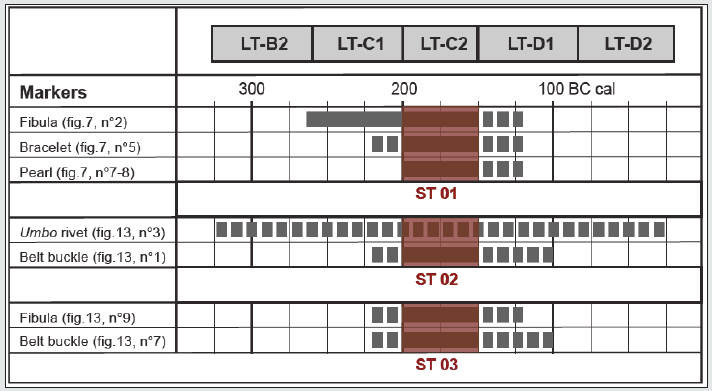
Table 2: Summary table of observations made for the four cremation structures. MNT = minimum number of taxa.
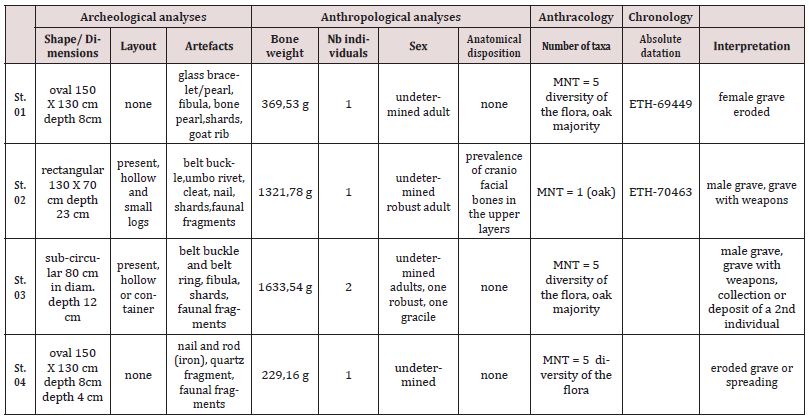
The discoveries of Pré-du-Stand are important in more than one way. They provide a unique insight into the funerary rituals of the middle La Tène period and confirm the antiquity of the cremation rite that appears during La Tène C2 on the western Swiss Plateau. Before this discovery, the oldest dated cremations of the end of the Iron Age were from the La Tène D around 150 BC [27], except for recent discoveries at Vufflens-la-Ville in the canton of Vaud (Switzerland). The cremations at Pré-du-Stand therefore represent an interesting sepulchral ensemble, in terms of both chronology and geographical location, the middle La Tène period being characterised by the rarity of funerary sites and settlements [22]. As a rule, the diffuse character of this type of structure and the absence of grave markers makes their discovery a rare event. Just like the discoveries at Vufflens-la-Ville, they bear witness to the population’s choice, at the local level, to dispose of the dead by cremations rather than the previous method of inhumation. By contrast, at the same time in the region of Bern, inhumation remained the rule. The progression of cremation as a ritual, visible in Southern France from West to East during protohistory [20] seems to also apply to Switzerland, where the western zone adopts it before the central and Alpine regions. Moreover, during the middle La Tène, there is a predominance of female and children’s graves in western Switzerland, male graves being less present, for unidentified reasons [26]. Considering this, the male cremations of St.02 and St.03 are of particular importance. These data therefore complete the few indicators of a middle La Tène occupation of the Geneva region. At the site of Geneva Cathedral, fibulas and glass ornaments suggest a female funerary occupation of Saint-Pierre Hill during the 2nd century BC [18]. In Parc de la Grange, meanwhile, a network of ditches and fragments of glass bracelets are attributed to the same period [22]. We can therefore only rejoice that future discoveries will shed more light on the funerary rituals of the La Tène populations of the Geneva territory.
Acknowledgments
The authors would like to thank OFROU, the Federal road office, and in particular Alexander Von Burg and Sébastien Schneider ; the Cantonal archaeological services of Geneva, and in particular Michelle Joguin Regelin and Jean Terrier ; Prof. Gilbert Kaenel of the University of Geneva for reviewing this manuscript and his expertise on the artefacts; Lionel Pernet, director of the Cantonal archaeology and history museum in Lausanne, Matthieu Demierre of the University of Lausanne and Jordan Anastassov of the University of Geneva for their expertise on artefacts ; Jocelyne Desideri of the University of Geneva, paleoanthropologist ; Patricia Chiquet of the Natural History Museum of Geneva and Mathieu Luret of the University of Geneva for the faunal remains determination; André Piuz of the Natural History Museum in Geneva ; Antoine de Haller and Agathe Martignier of the Department of Earth sciences at the University of Geneva for determining a few samples ; Branimir Šegvić of the Department of Geosciences of Lubbock (USA) for interpreting the EDS analyses ; Marisa Andosilla and Matteo Gios of the University of Geneva for logistics ; Colette Hamard and Bernadette Rey-Bellet of the Art and History Museum of Geneva for the X-rays of the iron objects; Valérie Gapany of the Art and History Museum of Geneva for cleaning the iron objects; Michel Tissot, farmer at the Grand-Saconnex; Claudine Abegg, Alexander Brown for translating the article.
Funding
OFROU, Federal road office, project to construct a new road (route des Nations); University of Geneva, Department F.-A. Forel for environmental and aquatic sciences, Laboratory of Prehistoric Archaeology and Anthropology.
References
- Anderson T, Castella D (2007) Une Ferme Gauloise à Courgevaux (FR, Suisse), Fribourg, Academic Press Fribourg (coll. Archéologie Fribourgeoise, 21).
- Badal García E (1992) L’Anthracologie Préhistorique: à Propos de certains Problèmes Mé Les Charbons de Bois, les Anciens Écosystèmes et Le Rôle de l’Homme, Bulletin de La Société Botanique de France 139(2-4): 167-189.
- Barge H (1982) Les parures du néolithique ancien au début de l’âge des métaux en Languedoc, Paris, CNRS.
- Bataille G (2001) Les Attaches de Ceinturon du Sanctuaire de La Villeneuve-Au-Chatelot (Aube), Archäologisches Korrespondenzblatt 3: 443-460.
- Berger L, Matt C P (1994) Zum Gräberfeld von Basel-Gasfabrik, in Jud P. (dir.), Die spätkeltische Zeit am südlichen Oberrhein/Le Rhin supérieur à la fin de l’époque celtique, Kolloquium Basel (17-18. Oktober 1991), Basel, Archäologische Bodenforschung des Kantons Basel-Stadt p. 92-106.
- Besse M, Steimer T (2017) Grand-Saconnex, Pré-du-Stand : Fouille Préventive, Site Pré (coll. Archéologie Genevoise 2014-2015: Patrimoine et Architecture. Série Archéologique, 3) p. 81-83.
- Besse M, Steimer T (2017) Grand-Saconnex GE, Pré-du-Stand. Chronique archéologique 2016, Annuaire d’Archéologie Suisse, 100 p. 188-189.
- Bocquet A (1991) Nouvelles tombes gauloises en Dauphiné, in Duval A. (dir.), Les Alpes à l’âge du Fer, Paris, CNRS (coll. Suppl. à la Revue archéologique de Narbonnaise, 22) p. 247-253.
- Boisaubert J L, Bugnon D, Mauvilly M (dir.) 2008: Archéologie et Autoroute A1, Destins Croisé 25 Années de Fouilles en Terres Fribourgeoises, Premier Bilan (1975-2000), Fribourg, Academic Press Fribourg (coll. Archéologie Fribourgeoise, 22).
- Brunaux J L, Rapin A (1988) Gournay II : Boucliers et Lances : Dépôts et Trophées, Revue Archéologique de Picardie, Paris, Errance.
- Brunetti C (2005) La fin de l’Âge du Fer à Lausanne : les sites de la Cité et de Vidy, in Berti Rossi S, May Castella C (dir), La fouille de Vidy Chavannes 11 1989-1990. Trois siècles d’histoire à Archéologie, architecture et urbanisme (coll. Lousonna, 8, Cahiers d’Archéologie Romande, 102) p. 343-362.
- Bruzek J (2002) A Method for Visual Determination of Sex, Using the Human Hip Bone, American Journal of Physical Anthropology 117(2): 157-168.
- Chabal L (1997) Forêts et Sociétés en Languedoc (Néolithique Final, Antiquité Tardive): L’Anthracologie, Méthode et Paléoécologie, Paris, Maison des Sciences de l’Homme (coll. Documents d’Archéologie Française, 63).
- Charollais J, Weidmann M, Berger J P, Engesser B, Hotellier J F, Gorin G, Reichenbacher B, Schäfer P (2007) La molasse du bassin franco-genevois et son Substratum, Archives des Sciences 60: 59-174.
- Corboud P, Rachoud-Schneider A M, Studer J (2008) L’environnement, in Gallay A (dir.), Des Alpes au Léman: images de la préhistoire, Gollion, Infolio p. 15-46.
- Curdy P, Kaenel G (2008) Les Celtes de l’Âge du Fer, in Gallay A (dir.), Des Alpes au Léman: images de la préhistoire, Gollion, Infolio p. 260-325.
- Curdy P, Mariéthoz F, Pernet L, Rast-Eicher A (2009) Rituels Funéraires chez les Sédunes, les Nécropoles du Second Âge du Fer en Valais Central (Ive-Ier Siècle av. J.-C. (coll. Archaeologia Vallesiana, 3, Cahiers d’Archéologie Romande, 112).
- Curdy P, Jud P, Kaenel G (2012) Chronologie de la fin de La Tène en Suisse occidentale, à partir des fibules issues de contextes funéraires, in Barral P., Fichtl S. (dir.), Regards sur la chronologie de la fin de l’âge du Fer (IIIe-Ier siècle avant J.-C.) en Gaule non méditerrané Actes de la table ronde tenue à Bibracte Chronologie de la fin de l’âge du Fer (IIIe-Ier siècle avant J.-C.) dans l’est de la France et les régions voisines Glux-en-Glenne, 15-17 octobre 2007, Bibracte, Centre archéologique européen p. 49-64.
- Dedet B (2004) Variabilité des pratiques funéraires protohistoriques dans le sud de la France: défunts incinérés, défunts non brûlés, Gallia 61: 193-222.
- Dedet B (2018) Coutumes funéraires en Gaule du Sud durant la Protohistoire (IXe-IIe siècle avant J.-C.), Arles, Éditions Errance/Actes-Sud.
- Demierre M, Poux M (2009) Etude du petit mobilier (IIe-Ier siècles avant J.-C.), in Bonnet C. (dir.), Les fouilles de la cathédrale Saint-Pierre de Genè Le centre urbain de la protohistoire jusqu'au début de la christianisation, (coll. Mémoires et Documents-In-8, Société d'Histoire et d'Archéologie de Genève) p. 181-229.
- Demierre M, Schopfer A, Julita B, Steudler A (2017) L’Agglomération Laténienne de Vufflens-La-Ville. (coll. Archéologie Vaudoise, Chroniques 2016) p. 34-35.
- Depierre G (2014) Crémation et Archéologie: Nouvelles Alternatives Méthodologiques en Ostéologie Humaine, Dijon, Éditions universitaires de Dijon.
- Duday H (2013) Doubles Funérailles et Cré Laissent-ils des Témoins Archéologiques? in Tillier A.-M. (dir.), L’homme et La Mort : L’Emergence du Geste Funéraire durant la Préhistoire, Paris, CNRS Editions, p. 131-146.
- Fabre L, Pernaud J M, Thiébault S (2003) Feu Sacré? Revue Archéologique de Picardie 21(1): 139-146.
- Feugère M (1985) Les Fibules en Gaule Méridionale de la Conquête à la Fin du Ve s. ap. J-C, Paris (coll. Suppl. à Revue Archéologique de Narbonnaise, 12).
- Gallay A (dir.) (2006) Des Alpes au Léman: images de la préhistoire, Gollion, Infolio.
- Gebhard R (1989) Pour une Nouvelle Typologie des Bracelets, in Feugère M (dir.), Le Verre Préromain en Europe Occidentale: Acquis Récents et Questions Ouvertes, Montagnac, Monique Mergoil p. 73-83.
- Gebhard R (1989) Der Glasschmuck Aus Dem Oppidum von Manching, Stuttgart, Steiner (coll. Die Ausgrabungen in Manching, 11).
- Girardclos S, Fiore J, Rachoud Schneider A-M, Baster I, Wildi W (2005) Petit-lac (western Lake Geneva) environment and climate history from deglaciation to the present: a synthesis, Boreas 34: 417-433.
- Haevernick T E (1960) Die Glasarmringe Und Ringperlen Der Mittel-Und Spätlatènezeit Auf Dem Europäischen Festland, Bonn, R. Habelt.
- Haldimann M A, André P, Broillet Ramjoué E, Poux M (2001) Entre résidence indigène et domus gallo-romaine. Le domaine antique du Parc de La Grange, Archéologie Suisse 24: 2-15.
- Holloway J (2009) Charcoal Burial in Early Medieval England. PhD diss, University of Cambridge, Cambridge.
- Jud P (2014) Où sont-elles donc toutes ces nécropoles celtiques ? in Bullinger J., Crotti P., Huguenin C. (dir.), De l'âge du Fer à l'usage du verre. Mélanges offerts à Gilbert Kaenel, dit "Auguste", à l'occasion de son 65e anniversaire, Lausanne, Cahiers d'archéologie romande (coll. Cahiers d'archéologie romande, 151) pp. 157-160.
- Jud P, Ulrich Bochsler S (2014) Bern, Reichenbachstrasse. Neue Gräber aus dem latènezeitlichen Oppidum auf der Engehalbinsel, Bern, Rub Media (coll. Archäologischer Dienst des Kantons Bern).
- Kaenel G (1990) Recherches sur la Période de La Tène en Suisse Occidentale: Analyse des Sé Lausanne, Cahiers d’Archéologie Romande (coll. Cahiers d'archéologie romande, 50).
- Kaenel G (2016) L’an -58 -Les Helvètes, Lausanne, Presses Polytechniques et Universitaires Romandes.
- Kaenel G, Müller F (1989) À Propos de Certains Types de Bracelets en Verre du Plateau Suisse, in Feugère M. (dir.), Le Verre Préromain en Europe Occidentale: Acquis Récents et Questions Ouvertes, Montagnac, Monique Mergoil p. 121-127.
- Landry C, Blaizot F (2011) Une sépulture de guerrier celte à Chens-sur-Léman (Haute-Savoie), Revue Archéologique de l'Est 60: 147-171.
- Lejars T (2013) La Tène: la Collection Schwab (Bienne, Suisse), Lausanne, Cahiers d’Archéologie Romande (coll. Cahiers d'archéologie romande,140-141).
- Leroy M (1986) Nécropoles et Rites Funéraires au Début du Second Âge du Fer en Lorraine, Les Cahiers Lorrains, 4: 295-303.
- Lotter A F (1999) Late-glacial and Holocene vegetation history and dynamics as shown by pollen and plant macrofossil analyses in annually laminated sediments from Soppensee, central Switzerland, Vegetation History and Archaebotany 8: 165-184.
- Martin Kilcher S (1981) Das Keltische Gräberfeld von Vevey VD, Annuaire de la Société Suisse de Préhistoire et d'Archéologie 64: 107-155.
- Moinat P, David Elbiali M (2003) Défunts, Bûchers et Céramiques: la Nécropole de Lausanne-Vidy (VD) et les Pratiques Funéraires sur le Plateau Suisse du XIe Au VIIIe s. av. J-C, Lausanne, Cahiers d’Archéologie Romande (coll. Cahiers d'archéologie romande, 93).
- Morel J, Meylan Krause M F, Castella D (2005) Avant la Ville: témoins des 2e et 1er siècles av. J.-C. sur le site d’Aventicum-Avenches, in Kaenel G., Martin-Kilcher S., Wild D. (dir.), Colloquim Turicense. Sites, Structures d’Habitats et Trouvailles Du 1er S. Av. J.-c., Entre le Haut-Danube et la Moyenne Vallée du Rhône, Colloque de Zürich, Janvier 2003, Lausanne: Cahiers d’archéologie Romande (coll. Cahiers d'archéologie romande, 101) p. 29-58.
- Morel J, Blanc P (2008) Les sanctuaires d’Aventicum. Evolution, organisation, circulations, in Castella D., Meylan Krause M.-F. (dir.), Topographie sacrée et rituels. Le cas d’Aventicum, capitale des Helvè Actes du colloque international d’Avenches, 2-4 novembre 2006, Bâle, Archéologie suisse, (coll. Antiqua, 43) p. 35-50.
- Moscariello A, Pugin A, Wildi W, Beck C, Chapron E, et al (1998) Déglaciation Würmienne Dans Des Conditions Lacustres à La Terminaison Occidentale Du Bassin Lémanique (Suisse Occidentale et France), Eclogae Geologicae Helvetiae 91(2): 185-201.
- Müller F (1996) Latènezeitliche Grabkeramik aus dem Berner Aaretal, Annuaire de la Société Suisse de Préhistoire et d'Archéologie 76: 43-66.
- Murail P, Bruzek J, Houët F, Cunha E (2005) DSP: A Tool for Probabilistic Sex Diagnosis Using Worldwide Variability in Hip-Bone Measurements, Bulletins et Mémoires de la Société d’Anthropologie de Paris 17(3-4): 164-76.
- Ogereau P, Figueiral I, Machado Yanes C, Uzquiano P (2001) Guide d’identification des Charbons de Bois Préhistoriques et Ré Sud-Ouest de l’Europe : France, Péninsule Ibérique et Iles Canaries, Paris, CNRS Editions.
- Reimer P, Austin W, Bard E, Bayliss A, Blackwell P, et al (2020) The IntCal20 Northern Hemisphere radiocarbon age calibration curve (0–55 cal kBP), Radiocarbon 62(4): 725-757.
- Roux B, Grand M (2005) Etude Anthropologique des Deux Frères Bénédictins du Prieuré Saint-Maurice (XIIe s.), Découverts en Septembre 1979 dans la Cour de l’Ancien Collège des Jésuites à Reims, Fascicule de la Journée Archéologique de Champagne-Ardenne p. 9-11.
- Ruffieux M (2006) Diversité des Rites Funéraires à La Tène Finale, (coll. Cahiers d’Archéologie Fribourgeoise, 8) p. 98-102.
- Ruffieux M, Vigneau H, Mauvilly M, Guélat M, Uldin T, et al (2006) Deux Nécropoles de La Tène Finale dans la Broye: Châbles/Les Biolleyres 3 et Frasses/Les Champs Montants, (coll. Cahiers d’Archéologie Fribourgeoise, 8) p. 4-111.
- Schmitt A (2002) Estimation de l’Âge au Décès des Sujets Adultes à Partir du Squelette : des Raisons d’Espérer, Bulletins et Mémoires de La Société d’Anthropologie de Paris 14 (1-2): 51-73.
- Schmitt A (2005) Une Nouvelle Méthode pour Estimer l’'Age au Décès des Adultes à Partir de la Surface Sacro-pelvienne Iliaque, Bulletins et Mémoires de La Société d’Anthropologie de Paris 17(1-2): 89-101.
- Schweingruber F H (1990) Anatomie Europäischer Hölzer, Bern, Stuttgart, Paul Haupt.
- Šegvić B, Girardclos S, Zanoni G, Arbiol Gonzales C, Steimer Herbet T, et al (2018) Origin and paleoenvironmental significance of Fe-Mn nodules in the Holocene perialpine sediments of Geneva Basin, western Switzerland, Applied Clay Science 160: 22-39.
- Suter P J, Ulrich Bochsler S, Meyer L, Nussbaumer M A (1990) Das latènezeitliches Brandgrab von Ittigen-Worblaufen, (coll. Archäologie im Kanton Bern, 1) p. 123-125.
- Thompson T (2015) The Archaeology of Cremation, Oxford, Oxbow Books, USA.
- Walker P L, Miller K W, Richman R (2008) Time, Temperature and Oxygen Availability: An Experimental Study of the Effects of Environmental Conditions on the Colour and Organic Content of Cremated Bone Schmidt C, Symes S (Eds.), The Analysis of Burnt Human Remains, Academic Press, London, UK p. 129-126.
- Willigens M P (1991) L’âge du Fer en Savoie et Haute-Savoie, in Duval A. (dir.), Les Alpes à l’âge du Fer, Paris, CNRS (coll. Suppl. à la Revue archéologique de Narbonnaise, 22) p. 157-226.
- Zepezauer M A (1993) Glasperlen Der Vorrömischen Eisenzeit III. Mittel- Und Spätlatènezeitliche Perlen, Marburg (coll. Marburger Studien Zur Vor-Und Frühgeschichte, 15).

Top Editors
-

Mark E Smith
Bio chemistry
University of Texas Medical Branch, USA -

Lawrence A Presley
Department of Criminal Justice
Liberty University, USA -

Thomas W Miller
Department of Psychiatry
University of Kentucky, USA -

Gjumrakch Aliev
Department of Medicine
Gally International Biomedical Research & Consulting LLC, USA -

Christopher Bryant
Department of Urbanisation and Agricultural
Montreal university, USA -

Robert William Frare
Oral & Maxillofacial Pathology
New York University, USA -

Rudolph Modesto Navari
Gastroenterology and Hepatology
University of Alabama, UK -

Andrew Hague
Department of Medicine
Universities of Bradford, UK -

George Gregory Buttigieg
Maltese College of Obstetrics and Gynaecology, Europe -

Chen-Hsiung Yeh
Oncology
Circulogene Theranostics, England -
.png)
Emilio Bucio-Carrillo
Radiation Chemistry
National University of Mexico, USA -
.jpg)
Casey J Grenier
Analytical Chemistry
Wentworth Institute of Technology, USA -
Hany Atalah
Minimally Invasive Surgery
Mercer University school of Medicine, USA -

Abu-Hussein Muhamad
Pediatric Dentistry
University of Athens , Greece

The annual scholar awards from Lupine Publishers honor a selected number Read More...




